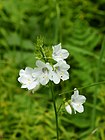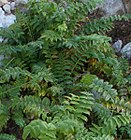Note: This is a project under development. The articles on this wiki are just being initiated and broadly incomplete. You can Help creating new pages.
Polemonium caeruleum - Greek valerian
Polemonium caeruleum is a hardy perennial flowering plant. The plant produces cup-shaped, lavender-coloured or white flowers. It is native to temperate regions of Europe.
Contents
- 1 Uses
- 2 Parts Used
- 3 Chemical Composition
- 4 Common names
- 5 Properties
- 6 Habit
- 7 Identification
- 8 List of Ayurvedic medicine in which the herb is used
- 9 Where to get the saplings
- 10 Mode of Propagation
- 11 How to plant/cultivate
- 12 Commonly seen growing in areas
- 13 Photo Gallery
- 14 References
- 15 External Links
Uses
Headaches, Fever, Epilepsy, Nervous complaints, Trembling, Palpitations of the heart, Vapours, Hysteric cases, Epilepsies.
Parts Used
Chemical Composition
Contains volatile oils, flavonoids, apigenin, luteolin, quercetin, kaempferol, tiliroside, triterpene glycosides including euscapic acid and tormentic acid, phenolic acids, and 3%–21% tannins.[1]
Common names
| Language | Common name |
|---|---|
| Kannada | |
| Hindi | |
| Malayalam | |
| Tamil | |
| Telugu | |
| Marathi | NA |
| Gujarathi | NA |
| Punjabi | NA |
| Kashmiri | NA |
| Sanskrit | |
| English | Jacob's Ladder |
Properties
Reference: Dravya - Substance, Rasa - Taste, Guna - Qualities, Veerya - Potency, Vipaka - Post-digesion effect, Karma - Pharmacological activity, Prabhava - Therepeutics.
Dravya
Rasa
Tikta (Bitter), Kashaya (Astringent)
Guna
Laghu (Light), Ruksha (Dry), Tikshna (Sharp)
Veerya
Ushna (Hot)
Vipaka
Katu (Pungent)
Karma
Kapha, Vata
Prabhava
Habit
Identification
Leaf
| Kind | Shape | Feature |
|---|---|---|
| Simple | Alternate | The leaves are compound i.e made up of two or more discrete leaflets |
Flower
| Type | Size | Color and composition | Stamen | More information |
|---|---|---|---|---|
| Unisexual | 2-4cm long | Blue to purple | 5 | The flower is radially symmetrical |
Fruit
| Type | Size | Mass | Appearance | Seeds | More information |
|---|---|---|---|---|---|
| General | 7–10 mm | The fruit is dry and splits open when ripe | Many | {{{6}}} |
Other features
List of Ayurvedic medicine in which the herb is used
Where to get the saplings
Mode of Propagation
How to plant/cultivate
A very easily grown plant, it prefers a moist well-drained fertile soil in sun or semi-shade.[3]
Commonly seen growing in areas
Margins of woods, Limestone hills.
Photo Gallery
References
External Links
- Ayurvedic Herbs known to be helpful to treat Headaches
- Ayurvedic Herbs known to be helpful to treat Fever
- Ayurvedic Herbs known to be helpful to treat Epilepsy
- Ayurvedic Herbs known to be helpful to treat Nervous complaints
- Ayurvedic Herbs known to be helpful to treat Trembling
- Ayurvedic Herbs known to be helpful to treat Palpitations of the heart
- Ayurvedic Herbs known to be helpful to treat Vapours
- Ayurvedic Herbs known to be helpful to treat Hysteric cases
- Ayurvedic Herbs known to be helpful to treat Epilepsies
- Herbs with Flowers used in medicine
- Herbs with common name in English
- Habit - Herb
- Index of Plants which can be propagated by Seeds
- Index of Plants which can be propagated by Cuttings
- Herbs that are commonly seen in the region of Margins of woods
- Herbs that are commonly seen in the region of Limestone hills
- Herbs
- Polemoniaceae








